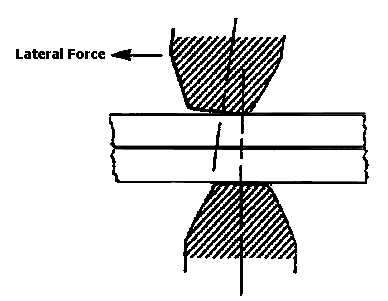Electrode Skidding/Sliding
Definition
When the electrodes touch the sheet metal, they may move a short distance along the metal surface. This is called skidding/sliding.
Description
A typical skidding/sliding example is shown in the figure. Skidding occurs more often with weld guns having insufficient stiffness. This typically happens on robot weld guns as designers try to reduce the weight on the robot arm. More energy is required to form a weld when skidding occurs. This is because the heating due to the current while skidding is wasted, so that less is available when the skidding stops and the final weld forms.

Electrode Skidding/Sliding
Detection
Possible indications of skidding/sliding are:
- Excessive Indentation
- Expulsion/Burn Through
- Inconsistent Weld Quality
- Nonround Weld
- Poor Class A Appearance
- Sheet Metal Distortion
- Undersized Weld
- Evidence of electrode skidding at or near weld
- Visual inspection of the electrodes movement upon contacting the sheets
- Observation of the bent shank
Significance
Quality, Workplace Issues, Cost, Downtime, Maintenance, Throughput (cycle time; PPH), are all potentially affected by this condition.
Subordinate Causes
- Poor Mechanical Connection
- Insufficient shank stiffness
- Poorly fixtured parts
- Gun is not normal to the sheets

